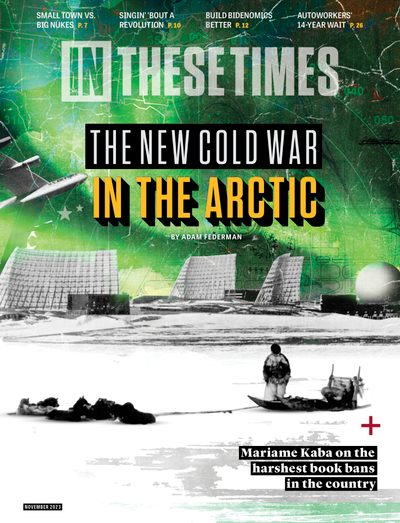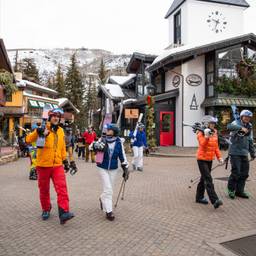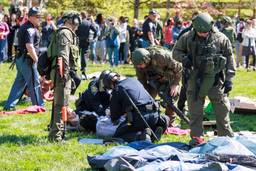The New Cold War in the Arctic
Amid rising geopolitical tensions, the U.S. is expanding its military presence in Greenland, increasing the risk of something going very wrong.
Adam Federman
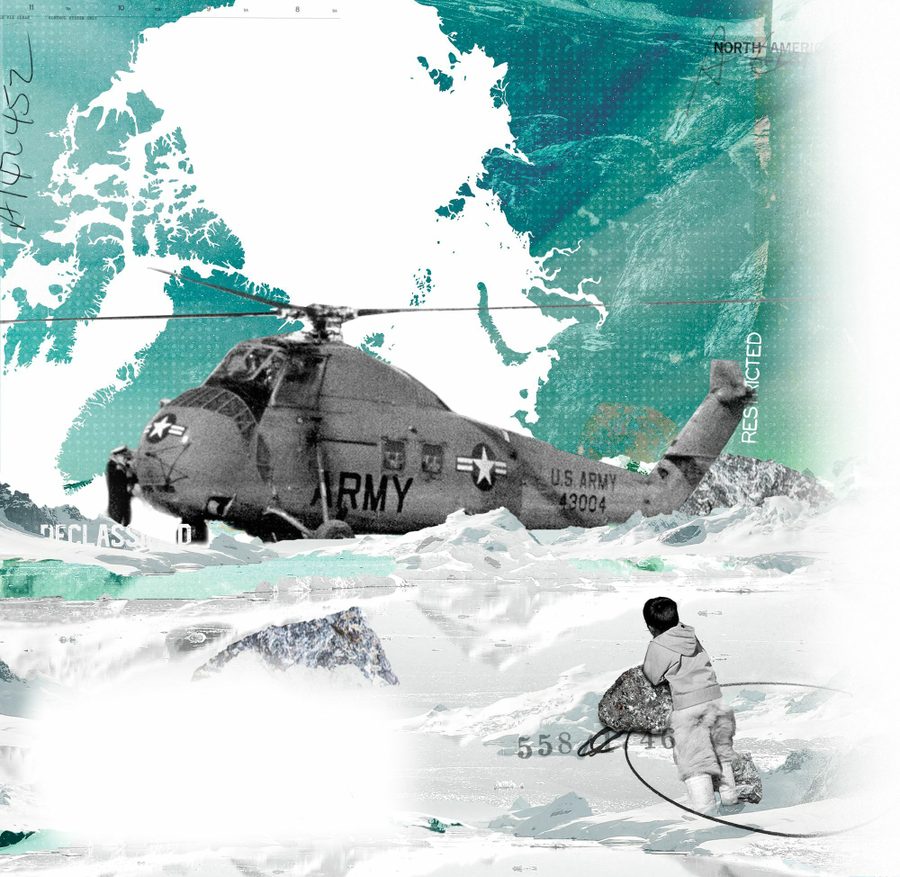
A Greenlandic boy watches a U.S. Army helicopter land at Thule Air Base in 1966. On Nov. 28, 2003, the Danish Supreme Court ruled the expropriation of native Greenlanders’ land to expand the U.S. base, in 1953, was legal. PHOTO ILLUSTRATION BY NADIA RADIC, SOURCE: NF/AFP VIA GETTY IMAGES
In the spring of 1953, when Regina Kristiansen was 14, she and her family were forced to leave their village of Uummannaq in northwestern Greenland, hundreds of miles above the Arctic Circle. At the behest of Danish authorities, who promised them new homes, they were given just a few days to gather their belongings. Kristiansen drove a dogsled across the ice for two days before reaching a barren island in Baffin Bay. Along with seven other families, they lived in makeshift tents for months as storms lashed the shore and winter approached. One woman gave birth in the tents. Another, a village elder, died before Denmark finished building their homes.
Altogether, 116 people from 26 families left Uummannaq, and their homes were burned to the ground. At the time, the Danish government — then a waning colonial power — characterized the move as voluntary. But in fact, the families were evicted to allow for the expansion of a U.S. Air Force base called Thule. The 233,000-acre base and deepwater port is one of the largest U.S. military installations in the world, and it played a prominent role in North American missile defense during the Cold War. It has also been a source of some of the U.S. military’s most closely held secrets.
Originally built following a 1951 bilateral defense agreement with Denmark — which granted the United States broad authority to operate on the island — Thule became the staging ground for a U.S. nuclear weapons program that was kept hidden from Greenland’s people. A missile launch facility, code-named “Project Iceworm,” was built deep under the ice sheet east of Thule, and, in 1968, a B-52 bomber carrying four thermonuclear bombs crashed a few miles from what had been Uummannaq. At one point, America had 17 military installations in Greenland, reflecting the Pentagon’s long-held view of the country as the “world’s largest stationary aircraft carrier.”
Kristiansen, 85, now lives in the mainland village of Qaanaaq, where many of the families driven from Uummannaq eventually settled. From her modest two-story home, she can see the island where her family first landed in 1953. Like her father and many others in this remote village — Greenland’s northernmost settlement — Kristiansen once worked at Thule. She has relatives in Texas. But she recalls with anger and grief how they were treated.
Before leaving Uummannaq, the families gathered at the cemetery to say goodbye. “We are leaving our graves behind,” her parents told her. “We are leaving our loved ones behind. We are leaving because the Americans are coming.”
This April, 70 years later, the U.S. military held a ceremony at the base during Greenland Heritage Week and acknowledged the “hardship and pain” caused by the relocation. The purpose of the event was to unveil a new name for the facility: Pituffik, a Greenlandic word that refers to the larger region, where Inuit hunters have lived for millennia, since Greenland’s first inhabitants traveled over the ice from Canada some 4,500 years ago. But despite the gesture of a name change, the ceremony, attended by top Danish and U.S. defense officials, also signaled America’s return.

Over the past 15 years, a quiet race has been underway among the world’s superpowers to gain control over the Arctic, with the United States, Russia and China all vying for dominance in a region with enormous strategic and economic value.
In 2019, President Donald Trump was widely ridiculed for offering to buy Greenland, which is still a Danish territory. But his ham-fisted bid, and the headlines it generated, aligned with decades of thinking that Greenland is essentially European real estate or an extension of North America. (President Harry Truman similarly tried to purchase Greenland in 1946, and first Norway, then Denmark have claimed the country since the 13th century.)
Although Trump’s offer was rebuffed, a number of behind-the-scenes efforts to exert U.S. influence followed. Some were soft-power moves to bolster Greenland’s economy through investments in trade, tourism and mining. Since 2019, the State Department has been working with Greenland’s government to survey the island’s resource-rich southern tier and streamline its regulatory and permitting system. In 2020, the United States reopened its consulate in Greenland’s capital, Nuuk, after an absence of nearly 70 years.
Some efforts are more akin to hard power, though, like the U.S. military’s imminent plans to spend millions of dollars on upgrades at Pituffik and its hopes to expand surveillance capabilities elsewhere in the nation.
The United States’ efforts to reclaim Greenland were precipitated by Russia’s military buildup in the Arctic and China’s push to become a regional power broker. Since 2005, Russia has revived more than a dozen Cold War-era military bases across the Arctic and, as sea ice diminishes, is ramping up use of the Northern Sea Route to ship oil and gas to Asia. As the war in Ukraine depletes Russia’s conventional forces, the Russian military has doubled down on its nuclear presence along the Kola Peninsula, which borders Finland and Norway. Then there’s the fact that the shortest route for a nuclear missile from Russia to America is over the North Pole, making Greenland the first land-based opportunity to detect an incoming missile.
But it’s not just Russia the United States is worried about. As the world seeks to develop the supply chains needed to produce the minerals used in batteries, electric vehicles, fighter jets and missile guidance systems, Greenland has become particularly attractive, given its proximity to North America and the fact that, by one estimate, the country holds a quarter of the world’s rare earth elements.
China, which currently dominates the rare earth market, declared itself a “near-Arctic state” in 2018, signaling its intent to expand its reach in Greenland through mining and infrastructure investments. But the United States has worked hard to keep China out. After a Chinese state-owned firm bid on three new airports in Greenland in 2018, Secretary of Defense James Mattis told his Danish counterpart to block the deal, making clear, in the words of the Wall Street Journal, that “Beijing must not be allowed to militarize this stretch of the Arctic.”
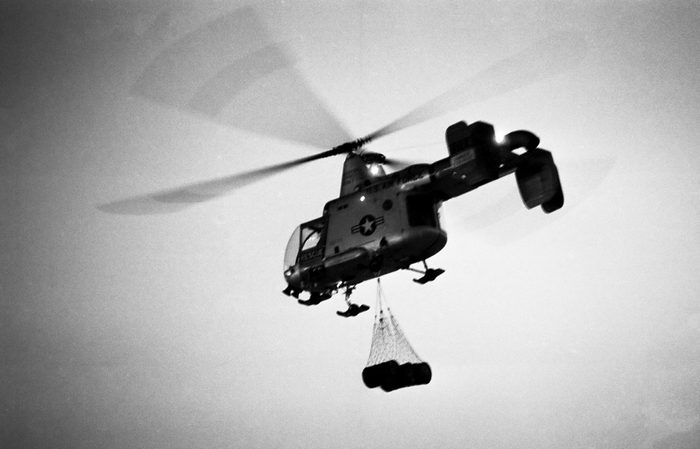
“The United States is not here just to make Greenland happy,” says Jørgen Hammeken-Holm, permanent secretary for Greenland’s natural resources and justice ministries. “They’re here on their own agenda. We know that very well.”
In many ways, Greenland finds itself at the center of a familiar story, one that the roughly 600 residents of Qaanaaq continue to live with. Earlier this year, a United Nations special rapporteur visited Greenland to outline threats facing the indigenous population. Recalling what happened 70 years ago, he wrote, “I remain preoccupied with the adverse environmental and social effects of military activities carried out in Greenland without the free, prior and informed consent of the Inuit people.”
But Greenlanders are equally preoccupied with the future and what a new Cold War in the Arctic will bring.
Approaching Nuuk by plane, the uniformity of the ice sheet has a mesmerizing effect. Its terminus, about 70 miles from the city, reveals a dazzling network of glacial rivers that form one of the largest fjord systems in the world. Scale is disorienting here. With three times the land of Texas and a population just under 57,000 people, Greenland is the most sparsely populated nation on earth. No roads connect its towns and villages, some of which are accessible only by boat. Most of the country is covered in ice.
Yet parts of Greenland are booming.
In 1953, when the United States was preparing to establish an embassy in Copenhagen, it closed its consulate in Nuuk, then a small village of 1,600 people. Today, at close to 20,000 people, Nuuk is a bustling diplomatic hub, expected to grow rapidly over the next decade. When I arrived in June, I shared a cab from the airport with a military analyst from the United Kingdom’s Ministry of Defence, in town to attend a NATO conference on Arctic security and surveillance. The week prior, the U.S. Coast Guard had participated in naval exercises with Denmark’s Joint Arctic Command, headquartered in Nuuk and responsible for the maritime defense of Greenland and the Faroe Islands, another former Danish colony. When the U.S. Consulate reopened in 2020, it was originally housed in the same building as the Joint Arctic Command, fueling talk among the diplomatic corps that Denmark was aligning itself too closely with U.S. interests. (The U.S. Consulate has since moved down the street.)
There are signs of construction everywhere in Nuuk, beginning with its airport, which is currently upgrading its terminal and runway. A conspicuous new “satellite town,” built on the hills just outside of the city, houses a large cadre of diplomats and Danish military personnel. The European Union announced plans to open an office in Nuuk in 2023. And 13 other countries, including Russia, have opened honorary consuls in the city, many recently established.
“It’s not accidental that our renewed interest in Greenland’s economic security coincides with the reopening of our diplomatic presence in Nuuk and the renewed desire [for our military] to operate more routinely out of northern Greenland,” says Joshua Tallis, an expert in maritime security with the Center for Naval Analyses, the Navy’s federally funded research center. “Those things are directly related to one another.”
While Greenland remains part of Denmark, it has far more autonomy today than it did during the height of the Cold War. In 1979, Greenland’s majority Inuit population voted in favor of home rule, establishing a parliamentary system and gaining control over internal affairs, initially including education and the environment and later natural resources too. In 2004, the U.S.-Denmark defense agreement was updated to provide assurances that Greenland would be included in discussions of U.S. military policy in the country. But Denmark — which provides more than half of Greenland’s budget — retains control of security and foreign policy.
To Sara Olsvig, a former member of both the Danish and Greenlandic parliaments and current chair of the Inuit Circumpolar Council — an international nonprofit that advocates for indigenous rights — America’s objectives in Greenland are obvious: Its military wants to maintain access to existing U.S. and Danish military bases (and possibly expand them), while its government wants Greenland’s mineral riches.
“There’s a clear interest to the U.S., which is shared by other NATO members,” says Olsvig. “That there’s a huge island with lots of resources that is geopolitically in a very important spot. And everyone around the table knows that. Including Greenland.”
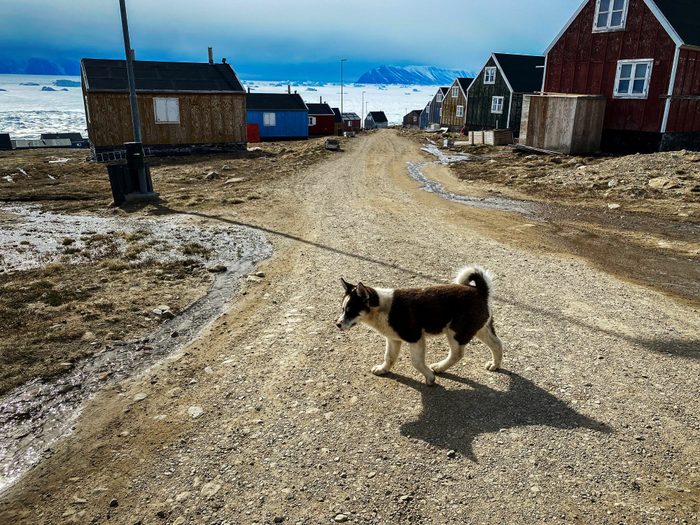
Russia’s recent revival of its Arctic military presence is part of why the Pituffik base is, once again, a U.S. priority. A top official at the base recently told Inside Climate News that Pituffik’s radar installation covers “the entirety of Russia” and plays an important role in current U.S. operations, given the “heightened state” of affairs stemming from the war in Ukraine. After decades of comparative neglect, the United States is planning to spend $3.95 billion on maintenance and upgrades to the base through 2034. But there are indications the United States has more ambitious plans.
In January, the Air Force deployed F-35 fighter jets from Alaska to Pituffik for the first time ever, as part of a joint U.S. Canadian military exercise. In late July, the U.S. Army Corps of Engineers announced it was seeking contractors capable of constructing new runways, aircraft fueling facilities and munitions storage at the base, renovations estimated to cost nearly $99 million.
The military has been tight-lipped about these developments. Asked if there are plans to expand the base, a spokesperson for Space Operations Command responded, “We can’t speculate on the future military presence at Pituffik Space base.” The Army Corps didn’t respond to multiple requests for comment.
But among military analysts, it’s well known that the United States would like to strengthen its surveillance capabilities in Greenland, particularly along the country’s less-developed eastern flank, improving U.S. and NATO capacity to monitor the straits through which Russian nuclear submarines must pass to reach the North Atlantic. In May 2022, a U.S. delegation traveled to Greenland to explore the possibility of establishing new radar installations elsewhere in the country. And there’s been academic discussion (including at a Danish military academy) about building a new deepwater port in the south that could support U.S. submarines and commercial ships, says Rasmus Leander Nielsen, head of the University of Greenland’s Center for Foreign and Security Policy.
The United States isn’t keeping its ambitions entirely secret, though. This summer, a nuclear-powered U.S. submarine made a port visit to Tórshavn in the Faroe Islands — something Denmark didn’t allow during the Cold War — following a similar visit to Iceland in April. According to the Navy Times, it was a demonstration “of the U.S. military’s ability to project power throughout the North Atlantic region.” At the same time, the Pentagon’s Defense Logistics Agency, which manages military supply chains, has been working to expand maritime refueling capabilities in the region, with Navy Cmdr. Joshua Fischer explaining, “Endeavors such as this will lay the groundwork for future mission success in the High North and Arctic as our Navy expands into more northern operations.”
Since 2020, the United States has also begun sending bombers on missions near the Kola Peninsula, where Russia’s largest fleet of nuclear-armed submarines is based. It’s a clear signal that the United States is prepared to attack Russia’s major military installations, says Michael Klare, a peace and world security studies professor for the Five College Consortium in Massachusetts, who has written extensively on U.S. military activity around the world.
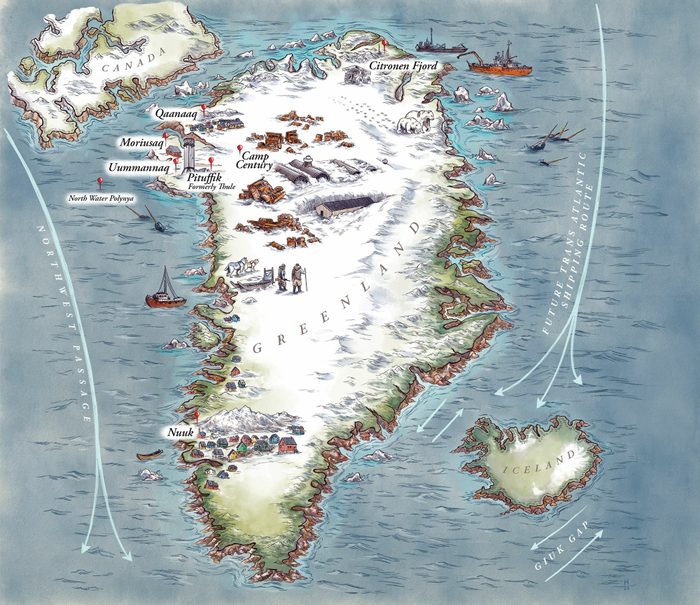
All of these developments are happening in the shadow of Russia’s war in Ukraine, which has upended regional power dynamics. Since the war began, the Arctic Council, the region’s premier forum for diplomacy, has paused nearly all engagement with Russia. In April, Finland became a member of NATO, with Sweden expected to follow suit, meaning every Arctic nation except Russia will soon be part of the military alliance. Denmark — which recently pledged to increase military spending to $21 billion, with significant earmarks for Arctic initiatives — is currently negotiating a new bilateral defense agreement that could allow U.S. military forces to deploy on Danish land. U.S.-Russian relations have reached a new low, with Russia suspending participation in its last remaining nuclear arms treaty with the United States and America ceasing to share information about its nuclear stockpiles with Russia. And in early October, an analysis of satellite imagery by the New York Times suggested that Russia may be preparing to resume testing of a new nuclear-powered missile in the Arctic, which some have dubbed a “flying Chernobyl.” Days later, Russian President Vladimir Putin appeared to confirm that Russia has completed a “successful test” of the missile and warned the country’s parliament could pull out of a treaty banning nuclear tests.
“Supposedly we live in an era of MAD — mutual assured destruction — with no incentive for either side to start a nuclear war,” says Klare. “But that’s being eroded.”
Not all signs of a Cold War revival are so obvious. In 2021, the U.S. Army published a policy blueprint, “Regaining Arctic Dominance,” that identified four primary drivers of this great northern power competition. After military developments, which focused on Russia and China, the second strongest driver was the Arctic’s “vast deposits” of mineral and energy resources. These include base metals, such as copper and nickel, as well as highly coveted rare earth metals, which are used in everything from electric vehicles and wind turbines to aircraft engines and advanced weaponry.
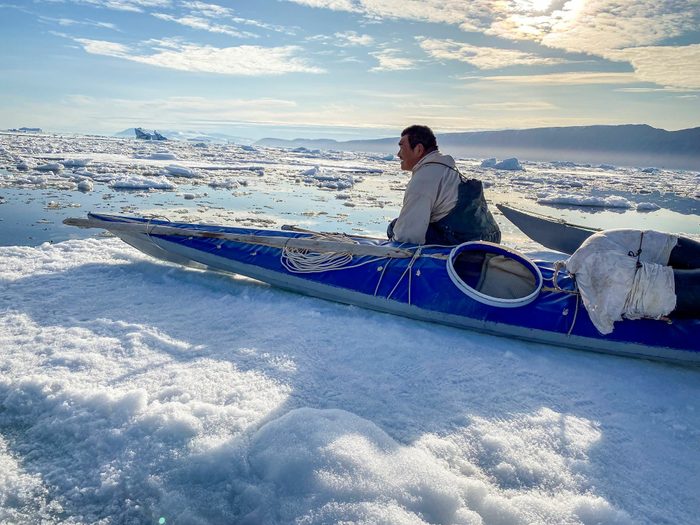
Greenland is at the heart of this battle as well, spurring talk of a “rare earths gold rush.” Billionaire investors Bill Gates, Jeff Bezos and Michael Bloomberg have lined up to fund exploration efforts for nickel and cobalt near Disko Bay, a UNESCO world heritage site known for its natural beauty and ice fjords. Greenland’s southern coast is believed to have some of the largest rare earth deposits in the world, which have attracted a flurry of investment.
Greenland’s left-leaning ruling party, which came to power in 2021, has effectively banned uranium mining and suspended new oil and gas exploration, declaring that “the future does not lie in oil.” But the government appears far more bullish about mineral development, which is often touted as the means for full Greenlandic independence. At this March’s Prospectors and Developers Association of Canada (PDAC) meeting in Toronto, Greenland’s then-minister of mineral resources and justice, Aqqaluaq B. Egede, repeated several times, “We’re aiming at unlocking large-scale mining in Greenland.”
The annual gathering, billed as the “world’s premier mineral exploration and mining convention,” featured a “Greenland Day,” emceed by Qupanuk Olsen, Greenland’s self-described “biggest influencer,” who also happens to be the in-country director for Australian mining company Ironbark Zinc Limited. In Egede’s keynote address, he pointed out that Greenland has 22 of the 50 “critical minerals” the U.S. Geological Survey has identified as essential to U.S. economic and national security. The United States seems well aware.
Since 2021, through a $6.3 million contract with the consulting firm Deloitte, the U.S. State Department has been quietly advising Greenland’s Ministry of Mineral Resources on “resource sector governance and capacity building.” A source who worked on the contract (but was not authorized to speak on the record) said the focus has been on cataloging data, with “substantial interest in the rare earth potential.”
The State Department declined, on multiple occasions, to make anyone available for this story, and the omertà even followed me abroad. Before traveling to both Nuuk and Toronto, I asked the State Department for interviews. Even its email denying my request was marked “off the record.” And at the PDAC conference, a member of the Greenlandic delegation said the State Department had “warned” them I’d be there.
But the State Department’s engagement, and the prospect of broader federal interest in the country, was a major topic of discussion during coffee breaks and a cocktail reception after Greenland Day, and with good reason: The U.S. government is moving closer to making direct investments in Greenland’s mining sector.
The U.S. Export-Import Bank, an executive branch agency that finances American development projects around the world, has its eye primarily on a titanium deposit roughly 50 miles south of Qaanaaq, not far from Pituffik. The black sand beaches in the former village of Moriusaq contain high levels of ilmenite, the source rock for most of the world’s titanium, a lightweight metal widely used in military aircraft, including Lockheed’s F-22 and F-35 fighter jets, as well as naval ships and submarines. China and Russia are among the world’s largest producers of refined titanium, controlling about 70% of the market — an imbalance the United States feels acutely. A recent op-ed in the U.S. military newspaper Stars and Stripes lamented, “Titanium is the next Cold War battle — and the U.S. is already losing it.”
In 2021, the Export-Import Bank issued a letter of intent to Bluejay Mining, the British company seeking to develop the titanium deposit, stating that it was considering investing $208 million in the project. And in June 2022, the bank’s president met with Greenland’s Prime Minister Múte Egede in Washington, during a visit where Egede also met with the U.S. deputy secretary of state.
Not all of the Export-Import Bank’s prospects make as much sense. In July 2022, representatives from the bank traveled to Greenland’s remote northern coast to visit a major zinc deposit known as Citronen Fjord. Unlike the Moriusaq titanium project, U.S. interest in the Citronen Fjord mine baffled industry experts.
John Thompson, former chief geoscientist at Teck Resources — which operates Alaska’s Red Dog mine, one of the world’s largest suppliers of zinc — was astonished to learn the United States was considering the investment. Unlike other base metals, there is no near-term supply crunch for zinc, nor is it a key metal for new technology. And there are large reserves closer to home, including Red Dog and several active mines in Canada.
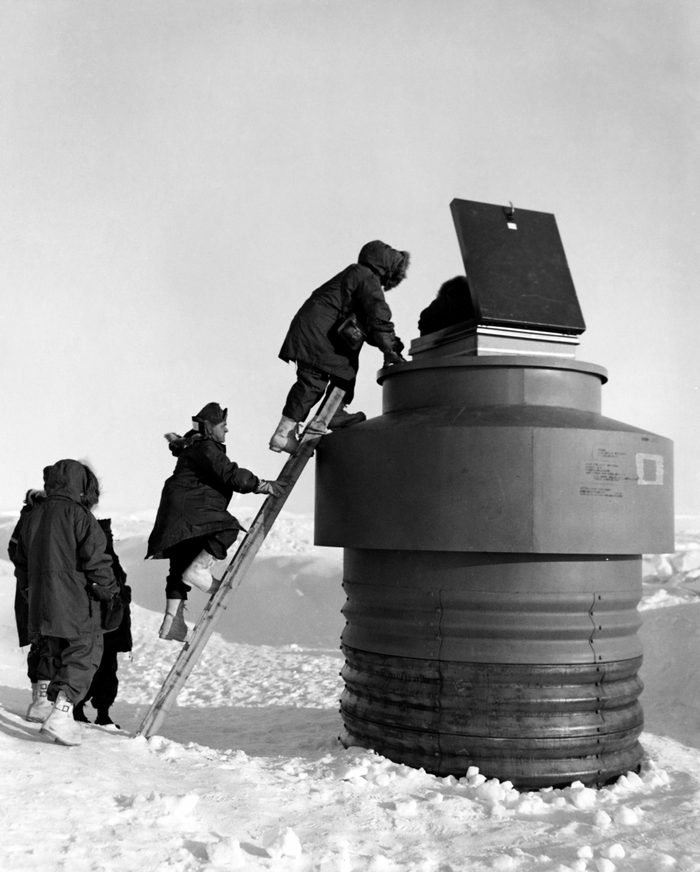
“There are things in Greenland that might be worth mining,” agrees Murray Hitzman, former associate director of the U.S. Geological Survey’s energy and minerals program. “But zinc is not one of them.”
What’s more, Thompson says, the concentration of zinc at Citronen Fjord is comparatively low and would not be considered economically viable, even in easier-to-reach places. The project has struggled to obtain the financing needed to move forward, possibly because of its extreme northern location and very limited shipping season — the fjord is only ice-free for six weeks each year. “It’s a mystery to me why they would think that is the best place to put their money,” Thompson says.
Unless, of course, U.S. mining investments in Greenland are designed not just to capture resources for the United States but to thwart China’s Arctic ambitions. When the Export-Import Bank first expressed interest — proposing, in 2020, to invest $657 million in Citronen Fjord — the Australian company behind the project, Ironbark Zinc Limited, had been partnering with a Chinese state-owned firm. If approved, the Export-Import Bank’s investment will come from a new $27 billion initiative known as the China and Transformational Exports Program, mandated by Congress in 2019. The program is clearly designed to compete with China’s Belt and Road Initiative, a massive global infrastructure project that seeks to expand China’s influence around the world. Ironbark’s Citronen Fjord project was the first to qualify under the new U.S. program.
“It’s been increasingly clear and increasingly public that the U.S. doesn’t want any Chinese investment, any Chinese infrastructure in Greenland,” says Ulrik Pram Gad, a senior researcher with the Danish Institute for International Studies in Copenhagen. “End of story.”
Ironbark and the Export-Import Bank declined to comment for this story.
Even projects that make more fiscal sense seem to have a secondary motivation. While titanium has more obvious benefits than zinc, U.S. interest in the Moriusaq project seems as tied to geography as securing access to resources. The site is fewer than 25 miles from Pituffik, and allowing China to get involved in a project so close to a U.S. military asset would be a strategic blunder.
“When I’m standing on the beach at the Dundas ilmenite project,” Bluejay Mining CEO Bo Møller Stensgaard told me, “I can see the radar installation at Thule.”
America’s quest for military and resource dominance comes at a steep social and environmental cost, though. Among the more than 750 U.S. military bases around the world, at least 18 have displaced local indigenous populations. And the fallout from becoming a staging ground for U.S. war games can be severe.
Ole Qujaukitsoq was 14 when an American B-52 bomber crashed on the ice west of Pituffik on January 21, 1968. His family was staying in a hunting settlement, and the crash shook the houses. Qujaukitsoq felt the heat and pressure from the blast as a quarter-million pounds of jet fuel burned. The plane’s payload of four thermonuclear bombs did not detonate, but they did release large amounts of radioactive plutonium and uranium into the water and air.
About a dozen men, including Qujaukitsoq’s older brother, were called to aid in the search and rescue. The operation and cleanup effort, which took months, was informally dubbed “Dr. Freezelove.” According to four sources who witnessed the crash, the locals were told nothing about the nuclear weapons on the plane nor given protective clothing.
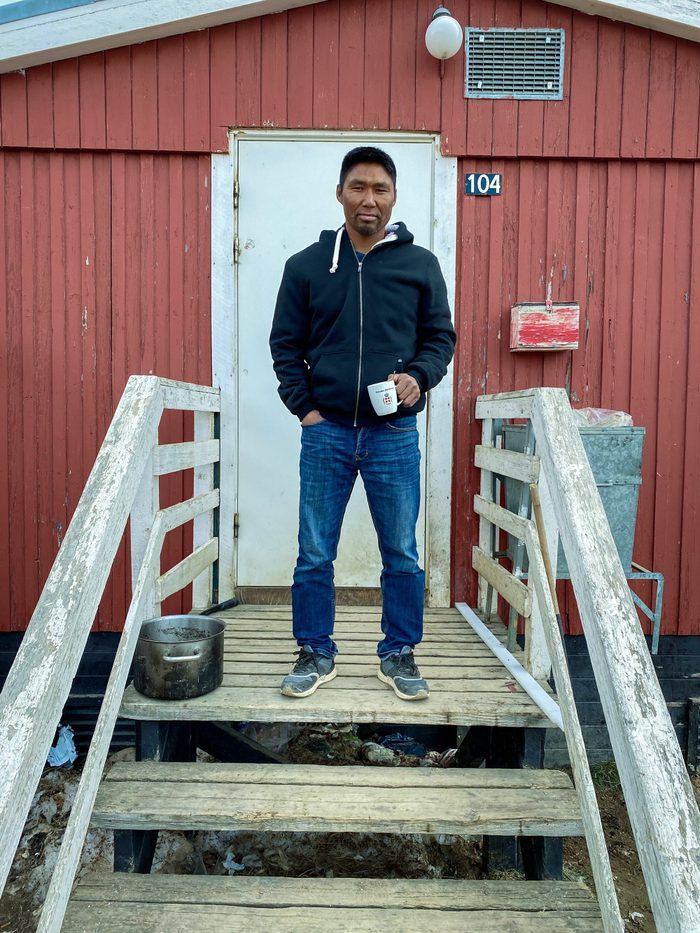
“The only instruction we received was that we should not drink from the surface of the snow,” Qujaukitsoq says. Radiation levels were so high that their clothing — gloves, boots and polar bear skin pants — was confiscated, according to Jens Zinglersen, the chief local agent with the Royal Greenland Trade Department who helped organize the search.
Many of the men later died of cancer. Zinglersen, who turns 90 in January, was recently diagnosed with colon cancer, which has spread to his liver and lymph nodes. He believes his illness, and the “many cancer deaths among former Thule employees,” is a direct result of their exposure to high levels of radiation after the crash. “In my situation it is impossible to think otherwise,” he wrote in an email. (The Danish government has denied any link between the exposure and reported illnesses.)
At the time, and for many years after, the United States and Denmark lied about the extent of America’s nuclear program in Greenland and claimed the plane had been rerouted due to an emergency. In fact, the United States had stored dozens of nuclear weapons at Thule Air Base beginning in 1958 and flew daily missions with nuclear-armed bombers over the base for more than a decade. These flights came to an end only after the crash in 1968.
During the same period, under the guise of scientific research, the United States built a network of tunnels under the ice sheet about 130 miles east of Thule. Known as “Camp Century,” the facility was designed to house up to 200 soldiers and hundreds of nuclear-armed missiles that could strike targets deep within the Soviet Union.
Along with revelations about the forced relocation from Uummannaq, these activities became public only after documents were declassified in the mid-1990s. In Greenland and Denmark, the news led to a diplomatic crisis, “Thulegate,” and reevaluation of the countries’ complicated relationship with the United States.
When Camp Century was officially shut down in 1967, the United States left behind an estimated 200 metric tons of diesel oil, likely large quantities of polychlorinated biphenyls (PCBs), 6.3 million gallons of sewage, and “nontrivial” amounts of radioactive waste. U.S. authorities believed the site would be “preserved for eternity,” a Cold War relic frozen in time, but as climate change accelerates — with the Arctic warming three times faster than the rest of the planet — Greenland’s ice sheet is rapidly melting.
If not dug up and removed, the toxic waste at Camp Century will end up in the ocean, near the village of Savissivik, about 100 miles south of Qaanaaq. The defense agreement between the United States and Denmark, however, excuses America from remediating former military sites in Greenland, meaning Greenland and Denmark will likely be left to clean up the mess.

As the United States reestablishes its military presence in Greenland, another mess may be facing the residents of Qaanaaq, including those already displaced once on America’s behalf. In a region where jobs are hard to come by, hunting is still the village’s lifeblood. The shoreline is cluttered with sleds, racks for drying fish, old boats and wooden containers filled with walrus meat used to feed teams of dogs. Traveling by sled dog is standard, and long narrow kayaks fitted with harpoons are still used for hunting narwhal.
“There’s no rule that you have to hunt by kayak here in Qaanaaq,” says Sofus Alataq, a 41-year-old hunter. “But we want to maintain our culture.”
Mining poses a new threat to this way of life and a region that, aside from the U.S. air base, has seen little development in the past 70 years. The titanium project borders one of the most productive marine ecosystems north of the Arctic Circle. Known as a polynya, it is an area of open water fed by ocean currents and freshwater from melting ice caps. It’s surrounded by sea ice most of the year. In early spring, when the sun reemerges after months of total darkness, the water warms, fueling an explosion of plant life that supports a wide array of marine mammals, including walruses, belugas, narwhals, seals, polar bears and dozens of seabirds, including auks, a staple of the local diet.
Dredging the beaches to separate the heavy mineral sand would generate large volumes of silt and wastewater, some of which would be pumped back into the ocean, destroying some of the primary food sources for walruses. According to the North Atlantic Marine Mammal Commission, shipping traffic would increase by up to 80% during the short ice-free season, when several species, including nearly a dozen on Greenland’s “red list” of threatened plants and animals, inhabit the area. Walruses and other migratory animals, including bowhead whales and narwhals — which are highly sensitive to noise — might leave the area altogether.
Bluejay Mining claimed the project will have limited impacts on marine resources but also acknowledges, in its environmental assessment, that it could take decades or longer to restore fragile ecosystems. But it’s not just wildlife habitats that would be destroyed. The ilmenite deposit also underlies the former village of Moriusaq, where several families forced out of Uummannaq in 1953 eventually settled, in part because of its proximity to some of the region’s best hunting grounds. Over time, the population dwindled, until the settlement was officially closed in 2010.
Bluejay Mining, which plans to demolish or relocate all of the homes in Moriusaq and restrict access to surrounding lands, contends that the settlement is of minor importance to locals. But Sofus Alataq, who grew up in Moriusaq, says hunters use the homes every spring and fall as a base camp. His older brother, Qajorannguaq Alataq, still lives there, year-round, in the home their father built.
In a written response to questions, Bluejay’s Stensgaard says the company has worked closely with former residents of Moriusaq to compensate them for their homes and is in frequent contact with Qajorannguaq Alataq. Once the mine is operational, Bluejay says accommodations will be made for hunters to travel through the area. (In September, Bluejay announced that the estimated titanium reserves at Moriusaq were smaller than previously thought and the company would be looking to partner with another developer before making any new investments in the project.)
There is some support for the project in Qaanaaq, and Stensgaard says the company is participating in a training program to hire local workers, but many residents are skeptical that the village will benefit. Ole Qujaukitsoq, who was born in Uummannaq two months before the forced relocation, said he’d like the Americans and Danes to visit Qaanaaq and make tangible investments in the community: Expand the airport runway to accommodate larger aircraft. Improve the roads and other infrastructure. Build a new gymnasium.
“Society has been left behind in Qaanaaq and the people have been forgotten,” Qujaukitsoq says.
Panigpak Daorana, another resident of Qaanaaq who studied business in Denmark, says extractive economies have rarely benefited Inuit communities in the Arctic. The titanium project will be no different. “They will take all the resources from our land,” he says. “It is the same story.”
“The essential risk is that people and the non-human environment will not be prioritized,” says David Vine, an anthropologist at American University and author of Base Nation: How U.S. Military Bases Abroad Harm America and the World. “That Indigenous people, those most vulnerable, will be put at risk in the interest of prioritizing U.S. government officials’ and corporate elites’ own interests in pursuing profit and really dangerous competition with Russia and China, not just in the Arctic, but on a global basis.”
When the Cold War ended, the Arctic was transformed from a theater of war to a region known for its uniquely peaceful cooperation among nations, captured in the Norwegian phrase, “High north, low tension.” That is no longer the case. Now tensions are rising, with unpredictable consequences for the region and the rest of the world.
This article was supported by the Leonard C. Goodman Institute for Investigative Reporting and produced in partnership with the nonprofit newsroom Type Investigations, where Adam Federman is a reporting fellow.
Adam Federman is a reporting fellow with Type Investigations whose work has appeared in Politico, the Washington Post, Wired and other publications. He is the author of Fasting and Feasting: The Life of Visionary Food Writer Patience Gray.
